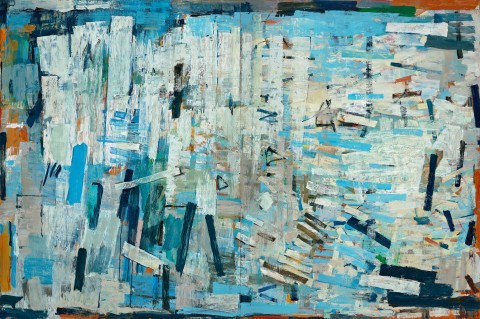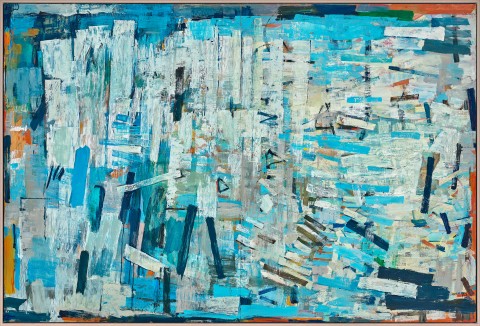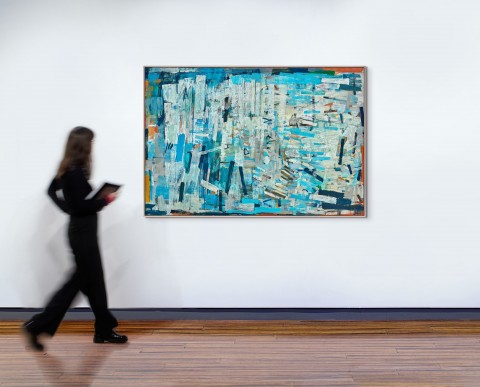TUSCAN LANDSCAPE, 1959
YVONNE AUDETTE
oil on plywood (diptych)
122.0 x 182.0 cm (overall)
signed with initials lower right: YA
signed, dated and inscribed with title on right panel verso: 1959 - 62 / audette / Tuscan Landscape / 1959 / audette
signed, dated and inscribed with title on left panel verso: audette / Tuscan Landscape / 1959
inscribed verso: A260
Private collection, Melbourne
As Mary Gabriel’s monumental book Ninth Street Women has demonstrated, women artists were an important and constant presence in the emergence of Abstract Expressionism in New York, contributing to dialogue, advocacy and exhibitions, and charting their own ways as strong, independent artists.1 While this may have been forgotten (or at least downplayed) by subsequent art history, it is into this exciting creative melange that Australia’s Yvonne Audette landed as a young practitioner in 1952, ready to learn and absorb, and determine her own course as a full-time artist. While Audette’s reminiscences of this period focus on her encounters with the art of male titans such as Willem de Kooning, Franz Kline and Bradley Walker Tomlin, to name but a few, the vibrancy and possibilities of the New York art world – studio visits, exhibitions, and experiences like her attendance at lectures at The Club2 – along with the vital presence of women artists of her generation3, no doubt reinforced her lifelong determination to live and succeed as an abstract artist.
Despite the riches of New York, Audette decided to leave for Europe in 1955, where she was immediately immersed in the wealth of its history and culture. After a period of travel in Spain, France and Germany, she settled in Florence and later, Milan, commuting and working between the two cities. Here she experienced the new forms of abstraction being created on the Continent, developing a circle of artist friends and colleagues that included Renato Birolli, Lucia Fontana, Giuseppe Santomaso and Emilio Vedova. In Italy, Audette developed her own unique language, as the confident works she created drew upon both her first-hand experience of American Abstract Expressionism and the ‘loose painterly qualities’ of the European non-figurative works that now surrounded her.4 As curator Julie Ewington has noted, Audette ‘channelled strong responses to Tuscan art, to the city of Florence, and to Italy as a rich repository of Western cultural life, directly into her painting … [not as] an archaising but an entirely contemporary project.’5
Audette establishes a sense of slow, meditative movement in Tuscan Landscape by layering emphatic, carefully considered brushstrokes across the composition to create strong vertical forms animated by the intersection of horizontal and diagonal marks. This combination of structure and the unexpected, and the work’s flashes of greens and earthy tones from beneath a palette of blues and white, create a sense of musicality in the work, as if the different elements each move to a score that plays only for them. As poet Chris Wallace-Crabbe has observed: ‘In her love of colour, her erasures and inscriptions, her visual music of bands and zigzags, there lies the vocabulary of these dynamic canvases … It could be said that she orchestrates colour, as richly as any Ravel: blushing, pavonine or cupreous, barred, brindled or jagged, it keeps revealing the inwardness of our being. She sings our silences.’6
1. Gabriel, M., Ninth Street Women: Lee Krasner, Elaine de Kooning, Grace Hartigan, Joan Mitchell, and Helen Frankenthaler: Five Painters and the Movement that Changed Modern Art, Back Bay Books & Little, Brown and Company, New York, 2018
2. Heathcote, C. et al., Yvonne Audette: Paintings & Drawings 1949-2014, Macmillan Art Publishing, South Yarra, 2014. p. 42. Located on Eighth Street, The Club was a salon-style members-only club whose ranks included many of New York's most important mid-century artists and thinkers.
3. To use the artists of Ninth Street Women as an example, Elaine de Kooning was 12 years older than Audette; Grace Hartigan, eight; Joan Mitchell, five and Helen Frankenthaler, two. Only Lee Krasner, at 22 years older, could be considered of an earlier generation.
4. Heathcote, op. cit., p. 52
5. Ewington, J., Yvonne Audette: Abstract Paintings 1950s & 1960s, Queensland Art Gallery, Brisbane, 1999, p. 22
6. Wallace-Crabbe, C., ‘Preface’ in Heathcote, op. cit., 23
KELLY GELLATLY


